Abstract
The effect of twisting phases on the polarization dynamics of a vector vortex beam with a spatially variant state of polarization (SoP) is investigated theoretically and experimentally. The twisted vector vortex optical field with the cross-phase modulation is experimentally generated and observed. The presence of the twisting phases on the vector optical field results in novel propagation dynamics and the evolution of polarization states. The optical field performs the process of compressing and stretching the orthogonal polarization components and the linear-circular polarization conversions during propagation. Different from the scalar twisted beams, the orthogonal polarization components of twisted vector beams can be compressed along the same azimuthal angle or the orthogonal azimuthal angles, depending on the signs of the twist intensity coefficients. For an anisotropic twisted optical field, the SoP and the optical field rotate, and the rotation behaviors are sensitively dependent on the twisting coefficients. Furthermore, the two vortex topological charges embedded within the orthogonal polarization component of a twisted vector vortex beam can be simultaneously identified by looking at the interference fringes of the twisting phases. This work reveals that a vector vortex beam and its SoP can be dynamically manipulated by twisting phases.
1. Introduction
As a non-separable quadratic phase existing in a partially coherent light field, the twist phase has aroused extensive interest since the first discovery of Simon and Mukunda in 1993 [1] because of its novel properties and potential applications [2,3]. Recently, a new type of twisting phase has been proposed [4,5,6], and it can be experimentally generated by a spatial light modulator (SLM) [7]. The new twisted beam that is modulated by the twisting phase (cross-phase) can act on completely coherent beams, and it has an arbitrarily controllable rotation angle during propagation [7]. Meanwhile, some potential applications of the new twisted beams have been found in micro-particle manipulation [8] and the measurement of a vortex optical field [9,10]. Nevertheless, most research about twisted beams is focused on the scalar optical field with uniform polarization in the field cross-section. Recently, the advances of vector beams with spatially variant states of polarization (SoP) have triggered some novel physical ideas and applications, e.g., 3D focal field manipulation [11,12], optical data storage [13], super-resolution imaging [14,15], optical information transmission [16], and second harmonic generation [17,18]. In particular, the modulation of the spatial phase on the vector beam has generated many interesting physical phenomena and applications, such as azimuthal modulation (vortex) [19,20,21], radial modulation, and the caustic phase modulation [22,23,24,25]. These modulations play an important role in the application, especially for the efficient manipulation of SoP during propagation. As a novel phase, the optical field can be rotated during propagation due to the existence of the twisting phase, and the velocity of rotation is dependent on the twist intensity coefficient [6]. The effect of twisting phases on a vector beam may lead to interesting phenomena and potential applications. In particular, the conventional method for the measurement of the vortex topological charge number is taking advantage of the interference of the vortex with a plane light wave. Recently, the detection of the two vortex phases in the vector vortex beams for the first time with a simple radial grating has been demonstrated [26]. The measurement of the topological charge number of a scalar vortex through a twisting phase has been observed [10,27], and the simultaneous measurement of two vortex topological charges in a twisted vector beam by twisting phases is anticipated.
In this work, the twisted vector beams with the modulation of the twisting phases and spatially variant SoP are experimentally generated and observed. The propagation dynamics and the evolution of the SoP of the twisted vector vortex optical field are analyzed in detail. The effect of twisting phases on the polarization dynamics of the vector optical field is systematically examined. The presence of twisting phases results in compression and stretching of the orthogonal polarization components and the linear-circular polarization conversions during propagation. The SoP and the optical field of the anisotropic twisted optical field are rotated by the twisting phase. The rotating angles and velocities are sensitively dependent on the twisting coefficients. Furthermore, the two vortex topological charges embedded in the orthogonal polarization components can be simultaneously measured through the twisting phases in a twisted vector vortex beam.
2. Experimental Generation of a Twisted Vector Optical Field
The experimental setup for the generation of a twisted vector optical field is shown in Figure 1a, and the spatial distribution of twisted phase uxy with u = 10 mm−2 is shown in Figure 1b. After the beam expansion and collimation (by the lenses L1 and L2), the cylindrical lenses CL1 and CL2 are employed to generate an anisotropic beam (i.e., the beam width along the x- and y-directions are not equal). The linearly polarized laser beam with a wavelength of 532 nm is incident on the reflective spatial light modulator (SLM, LETO, 1920 × 1080 pixels, each pixel has a 6.4 μm × 6.4 μm size). The transmittance function of the computed holographic grating (CHG) which is loaded in the SLM is T (x0, y0) = 0.5 + γ [cos(2πf0x0 + δ1) + cos(2πf0y0 + δ2)]/4, where γ is the modulation depth, and f0 is the spatial frequency of CHG. The δ1 and δ2 are the additional phase distributions for the vertical and horizontal CHGs, respectively. The +1-order diffractions of the holographic grating in the x- and y-directions are selected by the spatial filter (SF), followed by converting into left- and right-circular polarizations (or orthogonally linear polarizations) by the λ/4 (or λ/2) wave plate (WP). The two +1-order diffraction beam spots are recombined by the Ronchi grating (RG) in the rear focal plane of L5 to generate the desired vector light field. It should also be pointed out that the spatial frequency of the CHG needs to match the period of the RG.
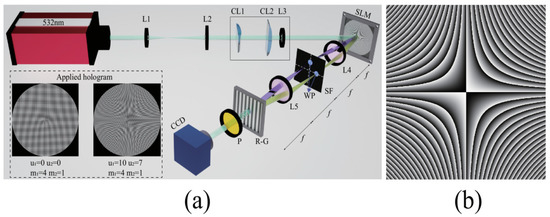
Figure 1.
(a) The experimental device diagram. L1-L5: lenses; CL1-CL2: cylindrical lens; SF: spatial filter; WP: (λ/4 or λ/2) wave plate; RG: Ronchi grating; P: polarizer; CCD: Charged-coupled device camera. (b) A twisted phase distribution uxy with u = 10 mm−2; here, the size of the plot is 6.9 × 6.9 mm2.
In this work, the phase distributions in the CHG are set as δ1 = u1xy + m1θ, δ2 = u2xy + m2θ, where uj (j = 1 or 2) is the twist intensity coefficients (TIC), mj is the topological charge numbers of a vortex, and θ = argtan(y/x), respectively. The generated twisted vector vortex optical field can be expressed as:
where σx and σy represent the beam width of the generated beam along the x- and y-directions, respectively. e1 = (ex + exp(iΔθ)ey), e2 = (ex − exp(iΔθ)ey). ex and ey are the unit vectors in the x- and y-directions, respectively. Here, the value of Δθ (0 or π/2) in Equation (1) is determined by the different wave plates in the experiment. When the half-wave plates are used in the experiment, Δθ = 0, and there are hybrid SoPs including linear, circular, and elliptical polarizations located at different positions of the field cross-section. On the other hand, Δθ = π/2 if a pair of quarter-wave plates is used and there are locally linear polarizations with different polarization directions located at different positions in the field cross-section. The hybrid SoP distribution (Δθ = 0) can be regarded as the superposition of two orthogonally linear polarization components (azimuthal angles are 45° and 135°), whereas the locally linear polarization distribution (Δθ = π/2) is the superposition of two orthogonally circular polarization components. The initial states of polarization (SoP) of the twisted vector beams with locally linear polarization (Δθ = π/2) and hybrid polarizations (Δθ = 0) are shown in Figure 2a,b by the Stokes parameters S0, S1, S2, and S3, respectively. Comparing the difference in SoP between the locally linear polarization (see Figure 2a) and hybrid polarizations (see Figure 2b), their S2 and S3 are reciprocal interchange, as analyzed above. To analyze the effect of the twisting phase on the SoP distribution, we rewrite the light field of Equation (1) as
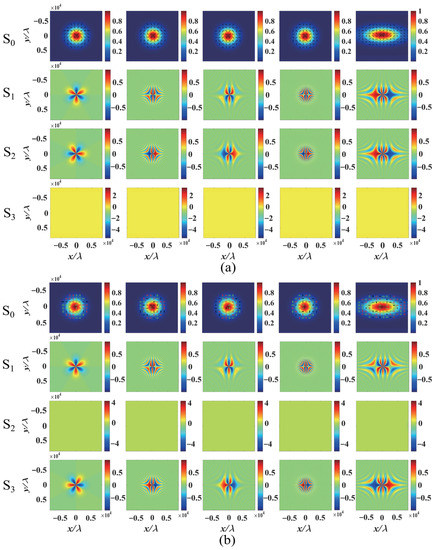
Figure 2.
The Stokes parameters of the initial SoP of a twisted beam with different modulating parameters for a (a) locally linear polarized light field; (b) hybrid polarized light field. The parameters in the figure from columns 1 to 5 are, sequentially: u1 = 0, u2 = 0, m1 = 4, m2 = 1; u1 = 10, u2 = 0, m1 = 4, m2 = 1; u1 = 10, u2 = 7, m1 = 4, m2 = 1; u1 = 10, u2 = −7, m1 = 4, m2 = 1; u1 = 10, u2 = 7, m1 = 4, m2 = −1. The plots in columns 1–4 are isotropic beam σx = σy = 5 mm, and the fifth column is an anisotropic beam σx = 2σy = 4 mm. In the plots in the first rows of (a,b), the black lines denote linear polarizations, and the ellipses in red and green represent the left- and right-circular polarizations, respectively. Here, the unit of ui is mm−2, and the size of any graph is 8500λ × 8500λ.
The initial SoP distributions of the optical field are modulated by the twisting phases u1xy and u2xy. An important parameter is the angle of polarization ellipse, describing the SoP distribution in position (x, y). It can be obtained from Equation (2) as
The angle of polarization ellipse α(x,y) increases with increasing values (u1 − u2)xy/2, with a certain vortex topological charge mj, as recognized from Equation (3). The effect of different TICs (u1 and u2) on the intensity pattern and the SoP distribution of vector light fields is shown in Figure 2. For the case with a locally linear polarization (Δθ = π/2), u2 = 0 and u1 take different values, e.g., u1 = 0 mm−2 and u1 = 10 mm−2, and the angle of polarization α(x,y) increases with the increasing values of u1xy/2. The polarization direction of the linear polarization rotates clockwise with increasing u1 in the first and third quadrants, whereas in the second and fourth quadrants, the polarization direction rotates counterclockwise with increasing u1, as shown in Figure 2a. It is because the signs of x and y are the same in the first and third quadrants; thus, the angle of polarization α(x,y) increases with the increasing values of u1. On the other hand, the signs of x and y are opposite in the second and fourth quadrants, and the angle of polarization α(x,y) decreases with the increasing values of u1. When u1 and u2 vary simultaneously, the angle of polarization α(x,y) depends on the values (u1 − u2)xy/2. Furthermore, the variation in polarization distributions results in the novel shapes of the x and y polarization components. The intensity pattern of the x- and y-components are closely related to the values of u1 and u2, as shown in the Stokes parameter diagram in Figure 2. In addition, the effect of the TIC on the SoP in the field cross-section of the anisotropic beams with σx ≠ σy is similar to that of the isotropic beam σx = σy, but the intensity distribution is an elliptical shape for the anisotropic beams instead of a circular shape of the isotropic beam, as shown in Figure 2. Moreover, the underlying physics of the effect of twisting phases on the angle of polarization ellipse α(x,y) of the beam with hybrid polarizations (Δθ = 0) are the same as those of locally linear polarization (Δθ = π/2). However, compared to locally linear polarization, there is an additional phase difference π/2 between the x- and y-components for the hybrid polarization distribution, as shown in Figure 2b.
3. SoP Evolution and Propagation Dynamics of a Twisted Vector Beam
The twisted vector vortex beams that propagate along the z-axis in free space can be calculated by the Rayleigh–Sommerfeld diffraction integral formula [28]:
Here the z-component is neglected under the paraxial condition. One of the novel properties of a scalar twisted light field is that the optical field initially compresses and then stretches during propagation. In addition, the beam can rotate about the propagation axis for the anisotropic case σx ≠ σy [6]. Since the twisted vector beams can be regarded as the superposition of two twisted vortices with orthogonal polarizations, the presence of twisting phases in the propagation of a vector beam with orthogonal polarizations may lead to the SoP redistribution, linear-circular polarization conversions, and the polarization rotation during propagation. The evolution of the SoP and the optical field of the twisted vector beams with different modulation parameters (TICs and vortex topological charges) in different propagation distances are shown in Figure 3. When the values of the TICs of the twisted vector beams take the same sign (i.e., positive or negative), the polarization components compress in the same direction with different speeds due to the different values of the TICs, as shown in Figure 3a. For the case of u1 = 10 mm−2, u2 = 15 mm−2, m1 = 4, m2 = −1, the right circularly polarization component completely compresses to a threadiness distribution along the azimuthal angle 135° at z = 0.8 m, whereas the left circularly polarization component uncompresses and distributes in the field cross-section. On the other hand, the left circular polarization component completely compresses to a threadiness distribution along the azimuthal angle 135° at z = 1.2 m, but the right-circular polarization component is uncompressed and distributed in the field cross-section. Meanwhile, the linear-circular polarization conversions are observed in the field cross-section during the different polarization components evolving with different modulation parameters. When the sign of u1 is opposite to that of u2, the two orthogonal polarization components of the vector optical field initially compress and then stretch along the orthogonal directions, e.g., 45° and 135° in the case of u1 = 10 mm−2, u2 = −10 mm−2, m1 = 4, m2 = −1, as shown in Figure 3b. The left- and right-circular polarization components simultaneously compress to a pair of orthogonal threadiness distributions at the propagation distance of z = 1.2 m. The underlying physics for the evolutions of the twisted vector beams with different signs of u1 and u2 are similar to the case with the same sign of u1 and u2, but the compression and stretching occur along the orthogonal directions of azimuthal angles 45° and 135°. The coherent superposition of the two orthogonal polarization components during propagation leads to the novel linear-circular polarization conversions and evolutions of SoP, as shown in Figure 3.
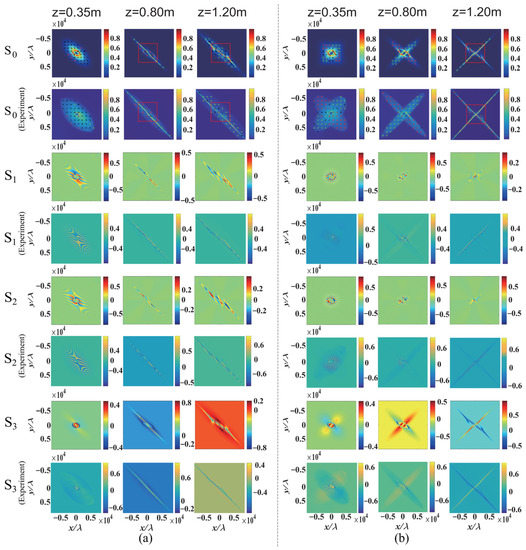
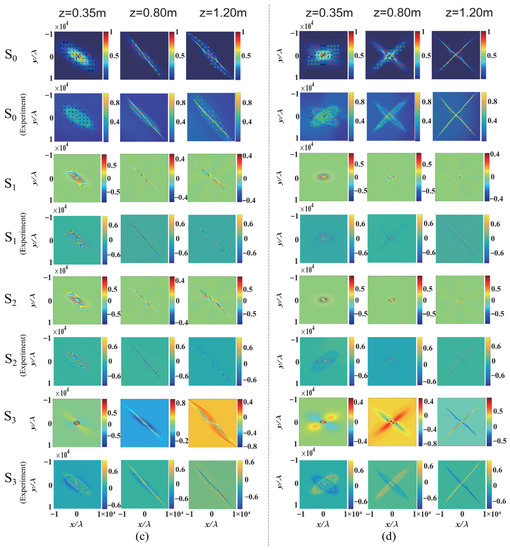
Figure 3.
Stokes parameters of isotropic (σx = σy = 5 mm in (a,b)) and anisotropic (σx = 2σy = 4 mm in (c,d)) twisted vector beams local linearly polarized in different propagation distances: (a) u1 = 10 mm−2,u2 = 15 mm−2, m1 = 4, m2 = −1; (b) u1 = 10 mm−2, u2 = −10 mm−2, m1 = 4, m2 = −1; (c) u1 = 10 mm−2, u2 = 15 mm−2, m1 = 4, m2 = −1; (d) u1 = 10 mm−2, u2 = −10 mm−2, m1 = 4, m2 = −1. The corresponding experimental results of S0 are shown in the second−row plots of each case.
In addition, the anisotropic twisted optical field σx ≠ σy rotates about the propagation direction due to the existence of the twisting phase during propagation, and the rotation and evolution of the optical field are strongly dependent on the TIC [6]. Another interesting feature is that there are two twisting phases embedded in the two orthogonal polarization components for the twisted vector beams. When the TICs of the vector beams take the same sign (positive or negative), the two orthogonal polarization components rotate in a similar direction. For the case of u1 = 10 mm−2 and u2 = 15 mm−2 (see Figure 3c), the two orthogonal polarization components rotate clockwise during propagation, but the rotation behaviors are different due to the different TICs. When the sign of u1 is opposite to that of u2, the two orthogonal polarization components of the vector optical field rotate in opposite directions. The left circular polarization component rotates clockwise, whereas the right polarization component rotates anti-clockwise for u1 = 10 mm−2 and u2 = −10 mm−2, as shown in Figure 3d.
The appearance of twisting phases in the propagation of a vector beam with the hybrid SoP distribution (Δθ = 0) also induces the conversion of linear-circular polarization and the rotation of SoP and optical field, similar to that of locally linear polarizations (Δθ = π/2). The underlying physics for the propagation dynamics of a vector beam with the hybrid SoP distribution are similar to those of the twisted vector beams with locally linear polarization (Δθ = π/2). However, there is an additional phase difference π/2 between the x- and y-polarization components for the hybrid SoP distribution compared to that with locally linear polarization, as shown in Figure 3 and Figure 4.
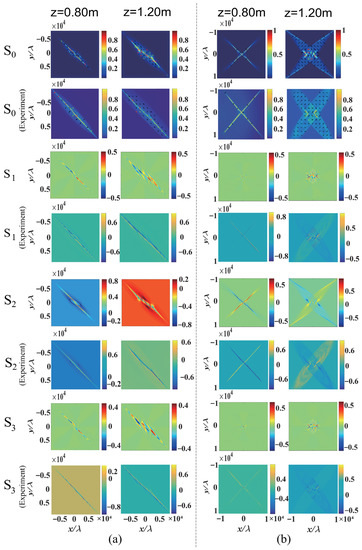
Figure 4.
Stokes parameters of isotropic and anisotropic twisted vector beams with hybrid SoP in different propagation distances: (a) u1 = 10 mm−2, u2 = 15 mm−2, m1 = 4, m2 = −1, σx = σy = 5 mm; (b) u1 = 15 mm−2, u2 = −15 mm−2, m1 = 3, m2 = −2, σx = 2σy = 4 mm. The corresponding experimental results of S0 are shown in the second−row plots of each case.
Obviously, the evolution of SoP distribution during propagation is sensitively related to the twisting phase modulation. The Stokes parameters S1 (the linear polarization components in the horizontal or vertical direction), S2 (the linear polarization components of 45° and 135°), and S3 (the left and right circular polarization components) perform the processes of compression and stretching and rotation (for the anisotropic twisted optical field σx ≠ σy) during propagation, as shown in Figure 3, Figure 4 and Figure 5. However, the propagation distances for the compression and stretching of different polarization components (S1, S2, and S3) are different due to the different initial phases of polarization components. The underlying physics are further discussed in Section 5.
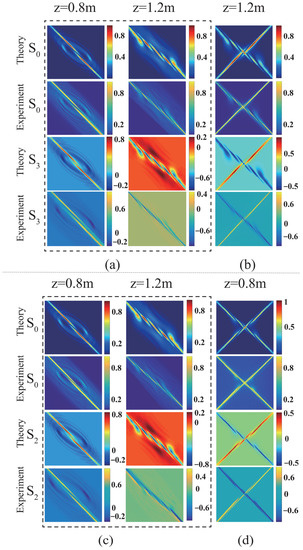
Figure 5.
Simultaneous measurement of two vortex topological charges in a twisted vector beam by the interference fringes. All the plots are a zoom of the central parts of the interference fringes in Figure 3 and Figure 4, as highlighted by the red dotted lines in Figure 3, and the actual size of any plot is 3269λ × 3269λ. (a) u1 = 10 mm−2, u2 = 15 mm−2, m1 = 4, m2 = −1; (b) u1 = 10 mm−2, u2 = −10 mm−2, m1 = 4, m2 = −1; (c) u1 = 10 mm−2, u2 = 15 mm−2, m1 = 4, m2 = −1; (d) u1 = 15 mm−2, u2 = −15 mm−2, m1 = 3, m2 = −2. The upper two rows are theoretical predictions, the lower two rows are experimental results. (a,b) are for locally linear polarizations (Δθ = π/2), and (c,d) are for hybrid polarizations (Δθ = 0).
4. Simultaneous Measurement of Two Vortex Topological Charges in a Twisted Vector Beam by Twisting Phases
Another interesting phenomenon about the twisting phase is the number of vortex topological charges that can be measured through a twisting phase [10,27]. As recognized from Equation (1), the topological charges m1 and m2, embedded in the two orthogonal polarization components e1 and e2, can be measured simultaneously due to the existence of the twisting phases u1xy and u2xy. Here, we demonstrate that the two vortex topological charges can be simultaneously measured based on different TICs, u1 and u2, by analyzing the intensity patterns of the twisted vector optical field. When the intensity patterns are compressed into threadiness distributions, the bright and dark interference fringes appear at the center of the light field. The number of interference dark fringes is equal to the number of vortex topological charges, and the sign of the vortex topological charges can be identified by observing the direction of the dark fringes. When the sign of TIC is opposite to that of the vortex topological charge (one is positive but the other is negative), the directions of the dark stripes are almost horizontal. For the case of the vortex topological charge m2 = −1 and u2 = 15 mm−2, a horizontal dark stripe appears at the propagation distance z = 0.8 m, as shown in Figure 3a. On the other hand, the directions of the stripes are almost vertical when the signals of TIC and the vortex topological charge are similar (both are positive or negative), e.g., there are four vertical dark stripes at the propagation distance z = 1.2 m for m1 = 4 and u1 = 10 mm−2, as shown in Figure 3a. If the signs of TIC are opposite, e.g., one is positive and the other is negative, the stripes with the orthogonal polarizations compress in the orthogonal directions, as shown in Figure 3b. In the case of u1 = −u2, the values and signs of two vortex topological charges can be simultaneously observed at a certain propagation distance, e.g., for the case u1 = −u2 = 15 mm−2, m1 = 4, m2 = −1 at z = 1.2 m (see Figure 3b). In addition, for the anisotropic intensity distribution σx ≠ σy, the twisted beam rotates about the propagation direction during propagation. However, the different polarization components are always compressed along the azimuthal angles of 45° or 135°, and the compressed stripes appear at different propagation distances due to the difference in twisting phases during propagation, as shown in Figure 3c,d and Figure 4b.
For the cases of the twisted vector beams with the locally linear polarization or the hybrid SoP, the two vortex topological charges can be simultaneously measured with different TICs, u1 and u2, by observing the intensity patterns (S0 distributions) of the twisted vector optical field. Figure 5 describes the zoom of the central parts of the corresponding interference fringes in Figure 3 and Figure 4, as highlighted by the red dotted lines in Figure 4. From Figure 5, the experimental results further provide evidence to confirm the theoretical predictions for the simultaneous measurement of two vortex topological charges in a twisted vector beam. In addition, it is important to note that the hybrid SoP distribution (Δθ = 0) can be regarded as the superposition of two orthogonally linear polarization components (azimuthal angles are 45° and 135°), whereas the locally linear polarization distribution (Δθ = π/2) is the superposition of two orthogonally circular polarization components. Therefore, the two vortex topological charges of the vector beam with the locally linear polarizations (Δθ = π/2) are also measured by the bright and dark interference fringes in the patterns of S3 (the left- and right-circularly polarized components), as shown in Figure 5a,b. Similarly, the two vortex topological charges for the vector beam with hybrid polarizations (Δθ = 0) can also be measured by looking at the fringes in the patterns of S2 (the 45° and 135° linearly polarized components), as shown in Figure 5c,d.
5. Discussion
The manipulation of a structured optical and its applications in the corresponding field have been an emerging topic in modern optics, ranging from optical forces on particles to quantum information processing [29]. The Poynting vector [30] and azimuthal energy flow [31] of a vortex have been demonstrated for the rotation of the optical field. In this work, the effect of twisting phases uxy on a vector optical field results in the symmetry break of the vortex phase and the change in the azimuth energy flow, leading to the redistribution of the state of polarization. Since the vector optical can be regarded as the coherent superposition of two vortices with orthogonal polarizations and different twisting phases modulations (see Equation (1), therefore, the evolution of the state of polarization at different distances can also be explained according to the coherent superposition of the two orthogonal polarization components due to the modulation of the twisting phases. For the case of locally linear polarizations (Δθ = π/2 in Equation (2)), the initial optical field can be treated as the superposition of two orthogonally linear polarization components with the same phase but different amplitude distributions (see Equation (2)). On the other hand, for the hybrid polarizations (Δθ = 0), the initial optical field can be considered as the superposition of two orthogonally linear polarization components with the phase difference π/2 and different amplitude distributions (see Equation (2)). Since the two orthogonal polarization components are modulated with different twisting phases (see Equations (1) and (2)), the two orthogonal polarization components perform the processes of compression and stretching and rotation (for the anisotropic twisted optical field σx ≠ σy) during propagation. The coherent superposition of the orthogonal polarization components leads to the redistribution of the SoP and the linear-circular polarization conversions during propagation, as shown in Figure 3 and Figure 4 for the distributions of the Stokes parameters S1, S2, S3.
As an important application of the structured optical field, the optical manipulation of a micro-particle with a structured vector beam has been widely exploited. Recently, a light-driven opto-thermocapillary nanomotor on solid substrates has been developed [32]. In this work, the existence of a twisting phase breaks the symmetry of the vortex phase and changes the azimuth energy flow in a vector optical field. It will inevitably lead to more complex polarization and angular momentum evolution during the propagation of the twisted vector light field. Moreover, the evolutions of polarization and angular momentum are sensitively dependent on the twisting phase. Therefore, the twisted vector beam may provide a new way for the potential applications for optical trapping and optical rotors.
6. Conclusions
We have experimentally and theoretically investigated the effect of twisting phases on the polarization dynamics of a vector light field. The modulation of the twisting phases in the vector beam results in the novel SoP distribution of the initial optical field. The appearance of the twisting phases leads to interesting phenomena such as the process of the compression and stretching of a twisted vector beam, the linear-circular polarization conversions, the rotation of the SoP, and the optical field for the anisotropic twisted optical field. Different from a scalar twisted beam, the two orthogonal polarization components of twisted vector beams can be compressed along the same azimuthal angle or the orthogonal azimuthal angles, depending on the signs of the twist intensity coefficients. Moreover, the two vortex topological charges embedded in the orthogonal polarization components can be simultaneously identified by observing the interference fringes in intensity patterns of a twisted vector vortex beam at a certain propagation distance.
Author Contributions
Conceptualization, R.-P.C.; methodology, R.-P.C. and Q.L.; validation, R.-P.C., K.-H.C., X.H. and Y.L.; investigation, Q.L., Y.H., C.L. and R.-P.C.; data curation, Q.L., Y.H., C.L. and R.-P.C.; supervision, R.-P.C.; writing—original draft preparation, Q.L.; writing—review and editing, R.-P.C., K.-H.C., X.H. and Y.L. All authors have read and agreed to the published version of the manuscript.
Funding
This research was funded by the Zhejiang Provincial Key Research and Development Program (No. 2022C04007) and the National Natural Science Foundation of China (Nos. 11874323, 62105291).
Institutional Review Board Statement
Not applicable.
Informed Consent Statement
Not applicable.
Data Availability Statement
Not applicable.
Conflicts of Interest
The authors declare no conflict of interest.
References
- Simon, R.; Mukunda, N. Twisted Gaussian Schell-model beams. J. Opt. Soc. Am. A 1993, 10, 95–109. [Google Scholar] [CrossRef]
- Gori, F.; Santarsiero, M. Twisted Gaussian Schell-model beams as series of partially coherent modified Bessel–Gauss beams. Opt. Lett. 2015, 40, 1587–1590. [Google Scholar] [CrossRef]
- Borghi, R. Twisting partially coherent light. Opt. Lett. 2018, 43, 1627–1630. [Google Scholar] [CrossRef]
- Cai, Y.; Korotkova, O. Twist phase-induced polarization changes in electromagnetic Gaussian Schell-model beams. Appl. Phys. B 2009, 96, 499–507. [Google Scholar] [CrossRef]
- Mei, Z.; Korotkova, O. Twisted EM beams with structured correlations. Opt. Lett. 2018, 43, 3905–3908. [Google Scholar] [CrossRef]
- Liu, Z.; Zhao, D. Effect of the astigmatic phase on the intensity of nonsingular beams during propagation. Laser Phys. 2019, 30, 015003. [Google Scholar] [CrossRef]
- Wan, L.; Zhao, D. Controllable rotating Gaussian Schell-model beams. Opt. Lett. 2019, 44, 735–738. [Google Scholar] [CrossRef]
- Zhang, Y.; Yan, H.; Zhao, D. Optical trapping Rayleigh particles with a twist effect. Opt. Lasers Eng. 2020, 130, 106101. [Google Scholar] [CrossRef]
- Wang, C.; Ren, Y.; Liu, T.; Liu, Z.; Qiu, S.; Li, Z.; Ding, Y.; Wu, H. Generating a new type of polygonal perfect optical vortex. Opt. Express 2021, 29, 14126–14134. [Google Scholar] [CrossRef]
- Wang, C.; Ren, Y. Measurement and shaping of perfect optical vortex via cross phase. arXiv 2021, arXiv:2102.10571. [Google Scholar]
- Man, Z.; Bai, Z.; Li, J.; Zhang, S.; Li, X.; Zhang, Y.; Ge, X.; Fu, S. Optical cage generated by azimuthal-and radial-variant vector beams. Appl. Opt. 2018, 57, 3592–3597. [Google Scholar] [CrossRef]
- Pan, D.; Chew, K.H.; Wu, Y.; Chen, R.P. Conversions of linear-circular polarizations and spin-orbital angular momentums in a focused vector vortex beam with fractional topological charges. Optik 2022, 252, 168473. [Google Scholar] [CrossRef]
- Lerman, G.M.; Levy, U. Tight focusing of spatially variant vector optical fields with elliptical symmetry of linear polarization. Opt. Lett. 2007, 32, 2194–2196. [Google Scholar] [CrossRef] [PubMed]
- Rong, Z.; Kuang, C.; Fang, Y.; Zhao, G.; Xu, Y.; Liu, X. Super-resolution microscopy based on fluorescence emission difference of cylindrical vector beams. Opt. Commun. 2015, 354, 71–78. [Google Scholar] [CrossRef]
- Segawa, S.; Kozawa, Y.; Sato, S. Demonstration of subtraction imaging in confocal microscopy with vector beams. Opt. Lett. 2014, 39, 4529–4532. [Google Scholar] [CrossRef]
- Gao, X.Z.; Pan, Y.; Zhao, M.D.; Zhang, G.L.; Zhang, Y.; Tu, C.; Li, Y.; Wang, H.T. Focusing behavior of the fractal vector optical fields designed by fractal lattice growth model. Opt. Express 2018, 26, 1597–1614. [Google Scholar] [CrossRef]
- Li, H.; Liu, H.; Chen, X. Nonlinear frequency conversion of vectorial optical fields with a Mach-Zehnder interferometer. Appl. Phys. Lett. 2019, 114, 241901. [Google Scholar] [CrossRef]
- Zhang, L.; Lin, F.; Qiu, X.; Chen, L. Full vectorial feature of second-harmonic generation with full Poincaré beams. Chin. Opt. Lett. 2019, 17, 091901. [Google Scholar] [CrossRef]
- Chen, H.; Hao, J.; Zhang, B.F.; Xu, J.; Ding, J.; Wang, H.T. Gengeration of vector beam with space-variant distribution of both polarization and phase. Opt. Lett. 2011, 36, 3179–3181. [Google Scholar] [CrossRef]
- Chen, R.P.; Chew, K.H.; Zhou, G.; Dai, C.Q.; He, S. Vectorial effect of hybrid polarization states on the collapse dynamics of a structured optical field. Opt. Express 2016, 24, 28143–28153. [Google Scholar] [CrossRef]
- Chen, R.P.; Chen, Z.; Gao, Y.; Ding, J.; He, S. Flexible manipulation of the polarization conversions in a structured vector field in free space. Laser Photonics Rev. 2017, 11, 1700165. [Google Scholar] [CrossRef]
- Chen, H.; Ling, X.; Li, Q.; Lv, H.; Yu, H.; Yi, X. Generation of double-ring-shaped cylindrical vector beams by modulating Pancharatnam-Berry phase. Optik 2017, 134, 227–232. [Google Scholar] [CrossRef]
- Zeng, T.; Ding, J. Three-dimensional mutiple optical cages formed by focusing double-ring shaped radially and azimuthally polarized beams. Chin. Opt. Lett. 2018, 16, 031405. [Google Scholar] [CrossRef]
- Chen, R.P.; Chen, Z.; Chew, K.H.; Li, P.G.; Yu, Z.; Ding, J.; He, S. Structured caustic vector vortex optical field: Manipulating optical angular momentum flux and polarization rotation. Sci. Rep. 2015, 5, 10628. [Google Scholar] [CrossRef]
- Li, B. Chirality sorting using a structured caustic vector vortex field. J. Opt. Soc. Am. B 2022, 39, 1676–1685. [Google Scholar] [CrossRef]
- Zhang, Y.; Li, P.; Zhong, J.; Qi, S.; Guo, X.; Wu, D.; Liu, S.; Zhao, J. Measuring singularities of cylindrically structured light beams using a radial grating. Appl. Phys. Lett. 2018, 113, 221108. [Google Scholar] [CrossRef]
- Shen, D.; Zhao, D. Measuring the topological charge of optical vortices with a twisting phase. Opt. Lett. 2019, 44, 2334–2337. [Google Scholar] [CrossRef] [PubMed]
- Duan, K.; Lü, B. Vectorial nonparaxial propagation equation of elliptical Gaussian beams in the presence of a rectangular aperture. J. Opt. Soc. Am. A 2004, 21, 1613–1620. [Google Scholar] [CrossRef]
- Rubinsztein-Dunlop, H.; Forbes, A.; Berry, M.V.; Dennis, M.R.; Andrews, D.L.; Mansuripur, M.; Denz, C.; Alpmann, C.; Banzer, P.; Bauer, T.; et al. Roadmap on structured light. J. Opt. 2017, 19, 013001. [Google Scholar] [CrossRef]
- Padgett, M.J.; Allen, L. The poynting vector in Laguerre-Gaussian laser modes. Opt. Commun. 1995, 121, 36–40. [Google Scholar] [CrossRef]
- Arlt, J. Handedness and azimuthal energy flow of optical vortex besms. J. Mod. Opt. 2003, 50, 1573–1580. [Google Scholar] [CrossRef]
- Li, J.; Kollipara, P.S.; Liu, Y.; Yao, K.; Liu, Y.; Zheng, Y. Opto-thermocapillary nanomotors on solid substrates. ACS Nano. 2022, 16, 8820–8826. [Google Scholar] [CrossRef]
Publisher’s Note: MDPI stays neutral with regard to jurisdictional claims in published maps and institutional affiliations. |
© 2022 by the authors. Licensee MDPI, Basel, Switzerland. This article is an open access article distributed under the terms and conditions of the Creative Commons Attribution (CC BY) license (https://creativecommons.org/licenses/by/4.0/).